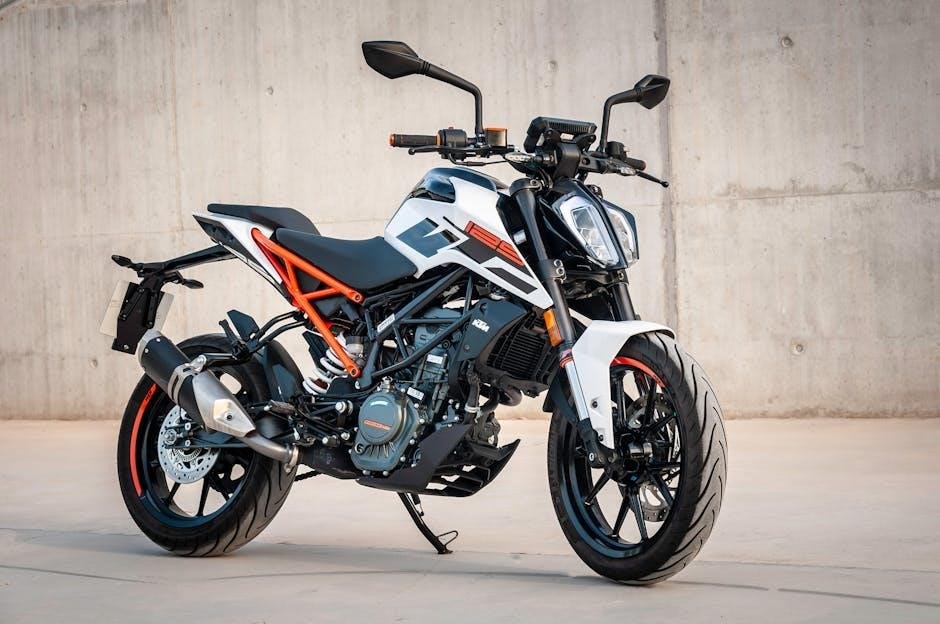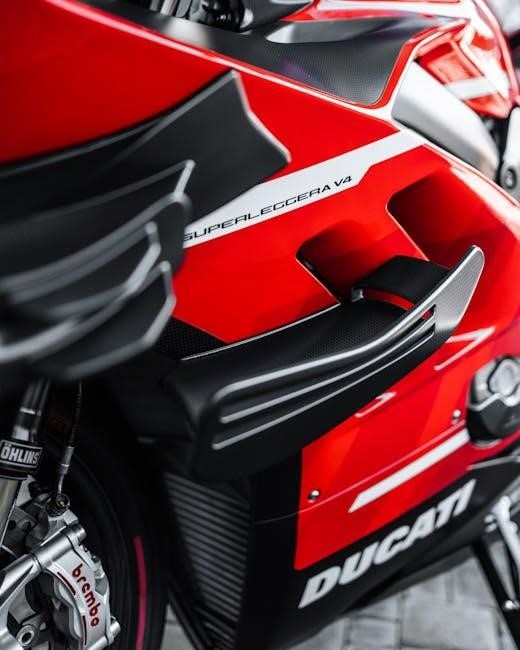Manual brakes rely solely on driver effort, offering simplicity and direct control, while power brakes use a booster for easier pedaling, enhancing comfort and stopping performance significantly․
What are Manual Brakes?
Manual brakes operate without power assistance, relying solely on the driver’s input to engage the braking system․ They lack a brake booster, which means the pedal requires more effort to press, especially in modern vehicles․ This setup is often associated with older cars or specific performance configurations, where drivers value simplicity and direct control․ Manual brakes typically use a smaller master cylinder bore and a longer pedal ratio to maintain a manageable pedal feel․ While they can be effective, they demand more physical effort from the driver compared to power-assisted systems․ This makes them less common in contemporary vehicles, where comfort and ease of use are prioritized․
Power brakes utilize a booster system, typically driven by engine vacuum or a hydraulic pump, to amplify the driver’s braking input․ This assistance reduces the physical effort required to press the brake pedal, making stopping easier and less tiring, especially in heavy vehicles or during frequent braking․ The booster works alongside the master cylinder to increase the pressure applied to the brake system, resulting in faster and more effective stopping․ While power brakes enhance comfort and performance, they introduce complexity and reliance on auxiliary systems, which can be a consideration for drivers prioritizing simplicity․ This system has become standard in modern vehicles, reflecting the demand for improved safety and driving ease․ Manual brakes originated in early automotive history, offering simplicity and reliability without auxiliary systems․ Power brakes emerged later, enhancing braking ease and effectiveness as vehicles evolved in size and speed․ Manual brakes have remained relatively unchanged in principle since their inception, relying on mechanical linkages and driver input․ Early systems used drum brakes, which were later complemented by disc brakes for improved heat dissipation and stopping power․ While they lack modern assists, manual brakes are valued for their simplicity and reliability, making them a preferred choice for classic car enthusiasts and certain performance applications․ Their straightforward design reduces maintenance and eliminates reliance on external systems, appealing to purists who appreciate a direct driving experience․ Over time, advancements in materials and engineering have enhanced their efficiency, ensuring they remain viable in niche automotive circles․ Power brakes emerged as a significant advancement in automotive technology, introducing a brake booster that utilizes engine vacuum to reduce pedal effort․ This innovation made braking more accessible and efficient, especially for drivers who found manual brakes physically demanding․ The system became widespread in the mid-20th century, offering a safer and more comfortable driving experience․ By leveraging vacuum assist, power brakes enabled drivers to achieve faster and more controlled stops with less strain․ Their adoption marked a shift towards modern braking systems, combining performance with ease of use․ This development catered to a broader range of drivers, enhancing overall vehicle safety and driver comfort․ Manual brakes require more pedal effort and offer a direct feel, while power brakes use a booster for easier control and improved stopping performance․ Manual brakes require significantly more pedal effort compared to power brakes, as they rely solely on the driver’s strength․ This increased effort can lead to fatigue during long drives or in heavy traffic․ Power brakes, on the other hand, use a booster system that assists with pedal pressure, making braking easier and less tiring․ The booster, typically vacuum-powered, amplifies the force applied to the pedal, allowing for smoother and more controlled stops․ However, some drivers prefer the direct feel of manual brakes, which provides more feedback and a sense of connection to the vehicle’s braking system․ This trade-off between effort and feel is a key consideration when choosing between manual and power brakes․ Power brakes generally offer superior braking performance due to the added assistance from the booster, which enables quicker and more precise stops․ This makes them particularly effective in emergency situations or at high speeds․ Manual brakes, while reliable, require more driver effort and can result in longer stopping distances, especially in urgent scenarios․ However, manual systems are often praised for their simplicity and consistent performance, as they lack the complexity of power-assisted components․ The choice between the two ultimately depends on the driver’s preference for ease of use versus direct control and simplicity․ Both systems can be effective when properly maintained and suited to the vehicle’s specifications․ Manual brakes are cost-effective and require less maintenance, while power brakes offer enhanced performance but involve higher costs and complexity in upkeep and repairs․ Manual brakes are generally more affordable to install and maintain compared to power brakes․ They require fewer components, such as no booster or additional wiring, reducing initial costs and the need for complex repairs․ Maintenance typically involves checking brake pads, rotors, and fluid levels, which are straightforward processes․ On the other hand, power brakes involve higher installation costs due to the added components like the booster and servo․ Maintenance can be more intricate, as issues with the vacuum system or booster can arise, leading to higher repair expenses․ However, the added convenience and performance of power brakes often justify the extra cost for many drivers․ Manual brakes offer a direct, tactile connection to the vehicle, appealing to purists who value simplicity and control, while power brakes provide a smoother, more effortless driving experience․ Manual brakes are often praised for their simplicity and reliability, as they lack the complex components of power brake systems, such as the booster and additional wiring․ This simplicity reduces the risk of mechanical failures, making manual brakes a more straightforward and dependable option for drivers who prioritize ease of maintenance․ Without the need for a vacuum booster, manual brakes rely solely on the driver’s input, eliminating potential issues related to vacuum leaks or booster malfunctions․ This straightforward design makes them ideal for drivers who value minimal complexity and want to avoid the hassle of maintaining additional brake components․ Their reliability also makes them a popular choice for vintage cars and enthusiasts who prefer a more direct driving experience․ Driver preference and feel play a significant role in choosing between manual and power brakes․ Manual brakes deliver a more direct and tactile driving experience, appealing to enthusiasts who enjoy precise control․ The firmer pedal requires more effort but offers better feedback, making it feel more connected to the vehicle’s braking system․ On the other hand, power brakes provide a lighter pedal and easier modulation, which is advantageous for long drives or in heavy traffic․ Many drivers prefer the convenience and reduced fatigue that power brakes offer, especially in modern vehicles․ Ultimately, the choice depends on whether the driver prioritizes a sporty, responsive feel or comfort and ease of use behind the wheel․ In modern vehicles, power brakes dominate due to their enhanced safety and comfort, while manual brakes are mostly limited to niche or classic car applications․ Power brakes significantly enhance safety by providing shorter stopping distances and requiring less pedal effort, especially at high speeds․ They utilize a brake booster, which amplifies braking force, ensuring quicker and more controlled stops․ This is particularly crucial in emergency situations where rapid deceleration is vital․ In contrast, manual brakes rely solely on the driver’s strength, potentially leading to slower response times and increased stopping distances․ While manual systems offer simplicity, power brakes are more reliable in modern driving conditions, reducing the risk of human error․ Their ability to deliver consistent and powerful braking makes them the preferred choice for safety-conscious drivers․ Power brakes thus strike a balance between performance and reliability, making them indispensable in today’s vehicles․
Installing manual brakes is straightforward, requiring fewer components compared to power brakes, which need a vacuum booster and additional plumbing․ For power brakes, ensure the booster is properly connected to the engine’s vacuum system and the master cylinder is correctly sized․ Regular maintenance involves checking fluid levels, inspecting hoses, and replacing worn pads․ Manual systems benefit from simpler inspections, focusing on cable integrity and pad wear․ Both systems require precise bleeding to eliminate air bubbles, crucial for consistent braking performance․ Proper installation and upkeep are vital for safety, ensuring reliable stopping power regardless of the braking system chosen․ Regular servicing helps prevent issues like spongy pedals or reduced braking efficiency, keeping the vehicle safe and responsive on the road․What are Power Brakes?

History and Development
The Evolution of Manual Brakes

Key Differences
Pedal Effort and Driver Input
Braking Performance and Effectiveness

Practical Considerations
Cost and Maintenance

Driving Experience

Simplicity and Reliability
Driver Preference and Feel

Modern Applications
Performance and Safety
Installation and Maintenance Tips